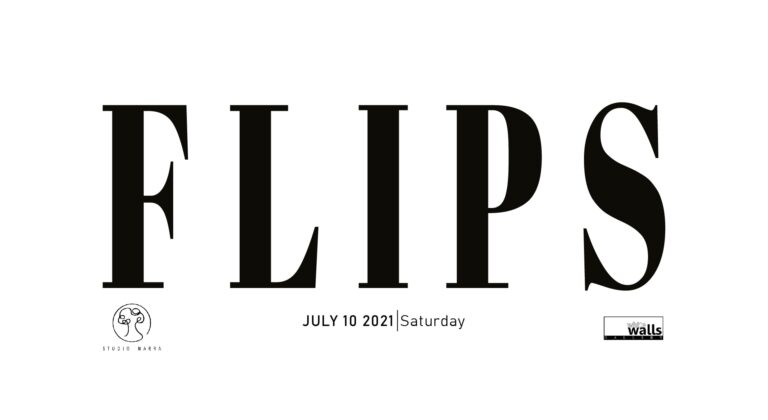
America is in the art.
FLIP. Fucking Little Island People. Flippant attitude. Flipping works at art auctions. This exhibit is an impish double jab at the colonial mentality eating away our collective identity and at the contemporary art scene which is reflective of this whitewashing. With puckish renditions of works by landmark American artists, Anjo Bolarda, Bam Garibay, Christian Culangan, Delmo, Emard Cañedo, Freddie Vicente, Jonathan Madeja, Kirk Tabanera, Lance Gomez, Mac Eparwa, Nina Garibay, and Roger Mond have a good laugh at the absurdity of our long relationship with America, poking fun at the twisted sensibilities that still permeate mainstream Filipino culture. The twelve featured works critique different aspects of this lopsided dynamic and its multi- pronged manifestations.
The drill is to create artworks in the style of blockbuster American auction artists to tell different narratives from Phil-Am history and the Fil-am experience to make light of a heavy continuing legacy while cheekily playing with the idea of bankable art. America is truly in our art, so much so that we paint pictures of American icons, cartoons, and even ordinary white people, copied from TV sitcoms, fashion magazines, and social media and call it Philippine Contemporary Art.
A recent example is a piece by a Filipino contemporary artist which broke records once again in an international auction. It depicts a typical American suburban scene -a children’s party complete with candy, cakes, and party hats in the yard surrounded by a white picket fence – except that the children have animal heads. The local art scene churns out recognizably derivative works from international art superstars, mostly American pop artists. This is in contrast to the strong national, even ethnic quality in the works of their Southeast Asian contemporaries like Heri Dono, Nyoman Masriadi, and Nguyen Manh Hung.
Taught to aspire to be Americans at an early age, we talk to our children in English, buy imported goods and try our best to keep up with the latest stateside trends. We look at the mirror that is our gadget screens and see ourselves in these white-skinned, blue-eyed, blonde- haired beings while perfecting the twang of our American accents. This aspiration to whiteness is reflected in Mac Eparwa’s “Unnatural Beauty” which depicts white worship in a grotesque ascension scene where brown-skinned figures morph and transcend their brownness.
This obsession with anything Americana disturbingly reveals our collective amnesia to the atrocities inflicted on us during the Philippine American War wherein around 20,000 Filipino soldiers died and more than 200,000 civilians perished. The beginnings of which are depicted by Delmo’s “Pwente (Bridge) about the “accidental” shooting at the San Juan Del Monte bridge that sparked the Phil-Am war and the death of Gen. Lawton at the “Battle of Paye” by Christian Culangan. The Clark Airbase and Subic Naval Base, legacies of this military occupation are depicted by Lance Gomez and Jonathan Madeja respectively. In “Carrot Sticks”, Nina Garibay tells of the archipelagos’ pacification through military force and the mandatory “education” of
the Filipino population. This cultural force-feeding is also the subject of Freddie Vicente’s “Kuwentong Fried Chicken” featuring the iconic fast-food chain’s mascot, Colonel Sanders feeding a drumstick to a half-naked Filipina in traditional garb seated on his bare lap.
Even though Filipinos have always taken the short side of the relationship, we remain incredulously optimistic. Kirk Tabanera’s “Just Look at the Bright Side” quotes a popular Filipino saying to refer to the “shining opportunity” Americans or just about any retired white ex-pat offers to impoverished Filipinas who see them as their ticket out of misery. A lot of these white ex-pats choose to retire in the Philippines because of the low cost of living, the opportunities for doing business as well as the pleasure of choosing among a crop of younger Filipinas usually from poorer backgrounds.
Bam Garibay, Roger Mond, and Anjo Bolarda tackle the legacy and plight of Filipino migrants in America then and now. “Isang Bagsak” (one rise/fall) by Garibay is a cartoon rendition of a picketing farm worker holding a megaphone shouting “Huelga!” (strike!). This is a homage to Larry Itliong one of the Fil-Am leaders of the highly successful Delano Grape Strike, lasting from 1965 to 1970, which united Filipino and Mexican worker unions in demanding labor reforms including higher wages and benefits for fruit farmworkers in California.
Roger Mond’s “Illegal Alien” shows a three-eyed Filipino in his boxers being attacked by watchdogs while a UFO lifts off in the background. Roger Mond’s comic take is a foil for the unsafe and increasingly violent reality migrants discriminated as illegal aliens face. This hostility threatens even Filipinos who have long resided in the country (hence the American-flag underwear). This makes one muse whether it is wiser for the three-eyed figure to still strive to fit in with the savage dogs devouring him than to just go back home.
Facing constant discrimination and stiff competition, poverty for an increasing number of migrants have driven them to ‘dumpster dive’. They forage for useful items from the discarded materials in dumpsters, like the figure in Anjo Bolarda’s “Nightcrawler” making literal the words ”one man’s trash is another man’s treasure.”
This exhibit is an unabashedly tongue-in-cheek variety show, appropriating culture jamming tactics in a call to get our acts together as artists with a hybrid background. Creating art that is conscious of our western training and colonially conditioned sensibilities is the first step in confronting our own situation, and hence the first step to action. By flipping the lens to take a candid look at ourselves, we explore possibilities for authentic, conscious, self-affirming creation.
– Alee Garibay

